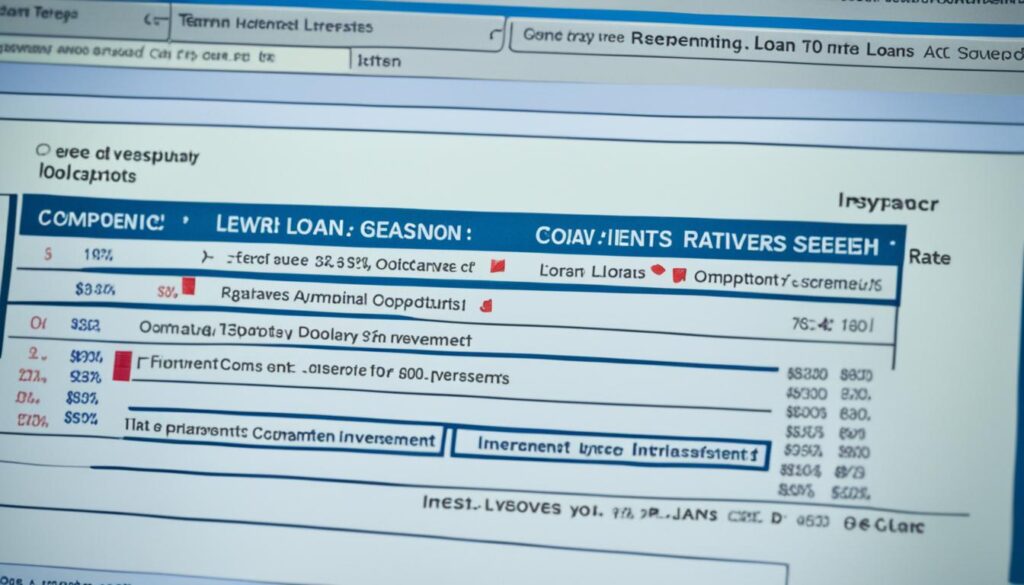Looking for a way to make money without much effort? Consider peer-to-peer lending online. It’s easy and has given investors great returns, better than many other choices. This article will show you how it works and how to start making money from online loans.
Key Takeaways:
- Online peer-to-peer lending is a great way to make passive income.
- It can offer better returns than many other investments.
- This method removes the need for banks, making it more direct.
- Investors can put their money in different loans to lower risk.
- Choosing a good lending platform is important.

Digital peer-to-peer lending has changed the game. You don’t just have to use banks for investing anymore. This way, you can lend money directly to people online, without a middleman.
Borrowers list what they need the loan for and their financial history on these platforms. As a lender, you can fund a part or all of a loan. Everyone agrees to the loan terms, like how long it will take to pay back and the interest rate. Then, borrowers pay back monthly, and lenders earn interest.
Peer-to-peer lending has lots of perks for investors. You can make passive income and possibly get high returns. By investing in various loans, you reduce risk. This investment also welcomes newcomers, as you don’t need much money to start. Lenders enjoy receiving monthly payments, too.
But, there are risks. A borrower might not pay back their loan, which could mean you lose money. Also, these platforms aren’t insured by the FDIC, so they’re not as safe as bank deposits. Make sure to check a borrower’s credit before investing and think about the risks.
To begin with peer-to-peer lending, pick a platform that fits your goals. Look at borrowers’ credit, choose loans wisely, and think about spreading your investments. Some platforms even automate investing, which could make things easier.
Having a good strategy is key for earning more. Focus on loans that offer higher interest. Keep an eye on how your loans are doing and change your strategy if needed. This can help you earn more.
There are many platforms like Prosper.com and Lending Club to choose from. Each has its own advantages. Look around to find one that meets your needs and risk comfort level.
To judge your investment’s success, look at its value and the returns. Spreading your money across different loans is smart to minimize risk. Watch how the platform handles non-payments and regularly update your investment choices to lower risks.
Peer-to-peer lending is a great way to invest, but don’t stop there. For more income options, check out real estate crowdfunding sites like Fundrise and CrowdStreet. They offer another way to make money passively through real estate projects.
What is Peer-to-Peer Lending?
Peer-to-peer lending, or P2P lending, lets people lend and borrow money directly through an online platform. This process bypasses banks, making it more efficient and cost-effective. It connects borrowers and lenders directly.
Using technology, P2P lending changes how we get loans. It’s an alternative to banks, helping borrowers get loans easily. Lenders can also earn interest on what they lend.
P2P platforms connect those needing loans with those offering cash. They ensure a safe, transparent space for both sides. This way, everyone’s interests are safeguarded during the lending journey.
“Peer-to-peer lending has brought a new level of accessibility and efficiency to the lending industry. It eliminates the need for banks and traditional financial institutions, offering a more streamlined and convenient way to borrow and lend money.”
Online platforms have gained popularity for their ease of use and fast application times. Borrowers submit loan requests online while lenders decide if they want to fund those requests.
Peer-to-peer lending lets individuals spread their investments across multiple loans. This spreads out the risk. Diversifying in this way can protect against losses and provide stable returns.
It also gives borrowers access to better interest rates. Without banks in the middle, P2P platforms can offer loans at lower rates. This makes loans more affordable for individuals and small businesses.
The Role of Online Lending Platforms
Online platforms are pivotal in peer-to-peer lending. They offer a secure, clear marketplace for borrowers and lenders to meet. Services include:
- Loan application processing
- Credit evaluation and risk assessment
- Loan matching and allocation
- Loan repayment management
- Investor reporting and analytics
Through these platforms, borrowers get access to various lenders. This increases their chances to find funding. Lenders get to choose from a variety of borrowers, matching their risk and investment preferences.
These platforms also offer tools to help lenders make smart choices. They can check borrower profiles, credit ratings, and past performance. Using this info, lenders can assess how risky a borrower is before deciding to lend.
Benefits of Peer-to-Peer Lending
Peer-to-peer lending benefits both borrowers and lenders:
| Borrowers | Lenders |
|---|---|
| Access to affordable loans | Potential for higher returns compared to traditional investments |
| Quick and efficient loan approval process | Diversification of investment portfolio |
| No collateral requirement for certain loans | Ability to support small businesses and individuals |
Peer-to-peer lending creates a win-win for borrowers and investors. It avoids traditional banks, connecting loan seekers with investors directly. Its convenience, competitive rates, and investment diversification make P2P lending a growing choice in online lending.
How Does Peer-to-Peer Lending Work?
In P2P lending, borrowers apply for loans using online platforms. This makes it easy for borrowers to get funds. At the same time, lenders get a chance to invest and make money. Let’s look at how borrowers and lenders interact:
Loan Application
Borrowers begin by applying for a loan online. They share details like how much money they need and why. They also share their credit history. This helps lenders see if lending to them is risky.
Lender Review
After the application, lenders review it. They check if the borrower can pay back the loan. This process helps lenders decide wisely about their money.
Funding the Loan
Lenders can then fund the whole loan or just part of it. It lets them spread their risk by investing in different loans. If one loan fails, they don’t lose all their money.
Loan Terms and Interest Rates
When a borrower gets the loan, they agree on how to pay it back and the interest rate. These terms are set to meet both their financial needs.
Monthly Loan Payments and Interest Income
Once they get the loan, borrowers start paying it back every month, with interest. This gives lenders a regular income. The amount they earn depends on the interest rates set at the beginning.
“P2P lending is good for both borrowers and lenders. Borrowers get the money they need, and lenders make money by investing in loans.”

An Illustrative Example of the P2P Lending Process
| Borrower | Lender |
|---|---|
| Borrower A submits a loan application on the P2P lending platform. | Lender B reviews the loan application and decides to invest. |
| Lender C also decides to invest in the same loan. | Borrower A receives funding for the loan. |
| Borrower A makes monthly loan payments towards the principal and interest. | Lenders B and C earn interest income from the loan repayments. |
This example shows how several lenders can fund one loan. This helps borrowers get what they need. It also allows lenders to make money together.
Benefits of Peer-to-Peer Lending
Peer-to-peer lending offers many advantages for those looking to make passive income. Let’s look at these benefits:
Diversification
Peer-to-peer lending lets you diversify your investment. You can spread your money across various loans. This reduces the impact of any single loan failing. It also lowers the risk to your overall investment.
Low Entry Barrier
Getting started with peer-to-peer lending is easy and doesn’t require much money. Some platforms let you invest as little as $25 per loan. This makes it a good choice for beginners or those with little capital. It opens up the lending market to more individuals.
Passive Income and Monthly Cash Flow
Peer-to-peer lending can help you earn passive income. After investing, you’ll get monthly repayments from borrowers. These payments are a mix of principal and interest. They can boost your monthly cash flow, helping you save or invest more.
“Peer-to-peer lending allows me to earn passive income on the side while diversifying my investment portfolio. The monthly cash flow from borrower repayments has been a great addition to my income streams.” – John, peer-to-peer lender.
With peer-to-peer lending, you can gain financial stability and work towards your financial dreams. It’s a great tool for building your wealth.

Peer-to-peer lending is a smart choice for those seeking high returns. Borrowers’ monthly payments mean lenders make money off interest. These rates are often better than those of savings accounts or other investments. This potential for higher returns is what makes peer-to-peer lending so appealing to investors.
Risks of Peer-to-Peer Lending
Peer-to-peer lending can offer good returns, but it’s key to know the risks. Knowing these risks helps lenders make smart choices and lessen possible losses.
Default Risk
One big risk is default risk. This means borrowers might not pay back their loans, which leads to losses for lenders. Things like economic bad times, job loss, or unexpected events can make borrowers unable to pay. Lenders need to check borrowers’ ability to pay back loans carefully to lower this risk.
Lack of FDIC Protection
Peer-to-peer loans don’t have FDIC insurance like bank deposits do. If a platform fails or a borrower doesn’t pay, lenders’ money isn’t protected by the Federal Deposit Insurance Corporation. Lenders should know this risk and understand their investments can be risky.
Illiquidity
Another risk is that peer-to-peer loans aren’t quickly turned into cash. Lenders should be ready to keep their money in the loan for its whole term. This can be months or years. This makes it hard to get to your money if you need it quickly.
Borrower Creditworthiness
Checking if borrowers are likely to pay back is key. Lenders should look into borrowers’ credit, stable income, and how much debt they have compared to their income. Choosing loans with borrowers who are likely to pay back helps lower the risk of not getting paid. Doing careful checks and using the lending platforms’ credit rating systems can help lenders make smart choices.
Peer-to-peer lending can be a good way to invest, but it’s vital to know the risks. Lenders should spread their investments, carefully pick borrowers, and keep an eye on their loans to reduce risks.
By understanding and managing the risks, lenders can do well in peer-to-peer lending and possibly get good returns on their money.

Getting Started with Peer-to-Peer Lending
Starting peer-to-peer lending the right way is key. You must pick the right platform, check borrower details, spread out your loans, and maybe use automation for investing. This helps you manage risks and aim for good returns.
Selecting the Right Platform
Choosing a good platform is the first step. It should fit your investment goals. Look for one with lots of loan types, detailed borrower info, and is easy to use. Sites like Prosper.com and Lending Club are good choices for secure investments.
Evaluating Borrowers and Loans
It’s important to check the borrower’s financial situation and credit history before investing. This helps you understand the risk and chance of getting paid back. Platforms give you data on borrowers to make this easier. Choosing financially solid borrowers means more steady repayments.
Diversifying Your Investments
Spreading your money across many loans is key in peer-to-peer lending. This cuts down the risk of losing money if a loan isn’t paid back. Aim to mix up your investments by loan type, purpose, and who you’re lending to. This strategy helps keep your earnings more steady.
Automated Investing for Simplicity
If you like an easier way, some platforms offer automatic investing. Just set your preferences like loan type, interest rate, and risk. Then, the platform invests for you based on these settings. This makes investing simpler by decreasing the need to pick each loan yourself.
By taking these steps, you’ll be more equipped to succeed in peer-to-peer lending. Make sure to pick a good platform, be smart about whom you lend to, diversify, and maybe use automation. This will guide you towards earning passive income through peer-to-peer lending.

Strategies for Maximizing Returns
For peer-to-peer lending, getting the most returns is key. Lenders must use smart strategies focused on different areas. These include loan types, credit ratings, interest rates, and picking the right loans. Understanding these areas helps lenders boost their earnings.
Focus on Loan Categories
Picking loan types with higher interest rates is a smart move. Each loan type comes with its own risk. Choosing higher-risk loans could mean better returns. Before deciding, lenders should closely look at each loan type’s risks.
Consider Credit Grades
Credit ratings affect the interest rates borrowers get. Loans to those with lower credit ratings usually offer higher rates. By looking at borrowers’ creditworthiness and ratings, lenders can find loans that give better returns.
Optimize Interest Rates
Interest rates greatly impact returns in peer-to-peer lending. Investing in higher-rate loans can boost earnings. Lenders should examine the loans available carefully. They should pick those with good rates, considering the risks involved.
Develop a Loan Selection Strategy
Creating a strong loan pick strategy is crucial. Lenders should look at loan length, borrower history, and payback terms. They must keep an eye on their loan portfolio’s performance. Adjusting the investment plan based on returns is important.
Regularly Monitor and Adjust
Lenders have to actively track their peer-to-peer lending earnings. Adjusting the portfolio based on returns ensures profit maximization. It’s vital to frequently check and analyze investment results. Doing this helps in spotting trends and making the right strategy changes.

Using these strategies will guide lenders to smarter decisions, boosting their peer-to-peer lending returns. Taking care of loan types, credit ratings, interest rates, and having a solid selection plan can help increase passive income and meet investment goals.
Peer-to-Peer Lending Platforms
Online lending marketplaces like Prosper.com and Lending Club are big names. They connect borrowers and lenders for peer-to-peer lending.
Prosper.com has been around for years, offering loans for many needs. Users can get loans for debt consolidation, home projects, and business funding. It’s a trusted site for earning passive income through lending.
Lending Club has funded lots of loans since starting. It covers many loan types, including personal and business loans. Here, you get detailed info on borrowers, helping you lend wisely.
These platforms are user-friendly, making investment management straightforward. You can see how your investments are doing and fine-tune your approach. They also put a lot of effort into keeping investments safe.
For those looking into peer-to-peer lending, check out Prosper.com and Lending Club. It’s smart to compare them to find the best fit for your investment style.
The Benefits of Peer-to-Peer Lending Platforms
Peer-to-peer lending comes with many perks:
- Diversification: You can spread your investment across various industries and risks.
- Control: Lenders can hand-pick loans or set up automatic investing for a custom approach.
- Transparency: Sites like Prosper.com and Lending Club share deep borrower details for informed lending.
- Passive Income: This lending earns you regular interest from the borrowers’ payments.
Using peer-to-peer lending platforms opens up new investment opportunities. They offer good potential returns and help in the financial success of borrowers.

P2P Lending Performance and Potential Risks
Peer-to-peer lending needs a good understanding of both gains and risks. Looking into account value and annualized return lets us see how profitable our investment might be. Using loan diversification strategies helps lower risks and protect your money. Knowing the default rate and how the platform handles defaults is key for making smart investment choices.
Account Value and Annualized Return
Keeping an eye on your account value shows how your investment grows. When borrowers pay back their loans each month, your account value goes up. This increase comes from the interest and principal repayment. Checking your account value regularly helps you understand your investment’s performance and make any needed changes.

The annualized return is another key performance indicator. It shows your investment’s average yearly return, helping you see how profitable it is. A higher annualized return means better performance and more passive income. However, remember that past returns can’t predict future ones and that diversifying is key to risk management.
Loan Diversification for Risk Minimization
By spreading your investment across many loans, loan diversification lowers the risk of any single loan failing. This strategy means investing in loans of various borrower types and risk levels. Diversifying lessens the risks of defaults and makes sure your overall investment isn’t badly affected by a few bad loans.
“Loan diversification is like building a safety net for your investment portfolio. It helps mitigate the risks associated with defaults and ensures a more stable and reliable passive income stream.”
Considering the Default Rate
The default rate is crucial for those investing in peer-to-peer lending. It’s the percent of loans not paid back, leading to lost money for lenders. Choose platforms known for handling defaults well to minimize their impact on your investment. Regularly checking the platform’s default management strategies and considering the default rate when investing is essential.
Good risk management in peer-to-peer lending needs research, ongoing monitoring, and updates to your portfolio. By knowing about performance indicators, using diversification strategies, and judging default rates wisely, you can make the most out of peer-to-peer lending for your passive income.
Explore Other Passive Income Investment Opportunities
There are many investment options out there besides peer-to-peer lending. Among them, real estate crowdfunding stands out. It’s an exciting way for you to put money into real estate projects.
Have you heard of Fundrise and CrowdStreet? These platforms make it easy for you to join real estate investments. With real estate crowdfunding, you can spread out your investments. This way, you might make money from rent and when property values go up.
Looking into these new investment ideas can boost your passive income. It’s smart to mix things up and not just stick to one investment type. While peer-to-peer lending is great, exploring different options is key to financial growth.
If you’re an experienced investor or just starting, consider Fundrise and CrowdStreet. They open up new paths for earning passive income. Plus, they could help you build your wealth.